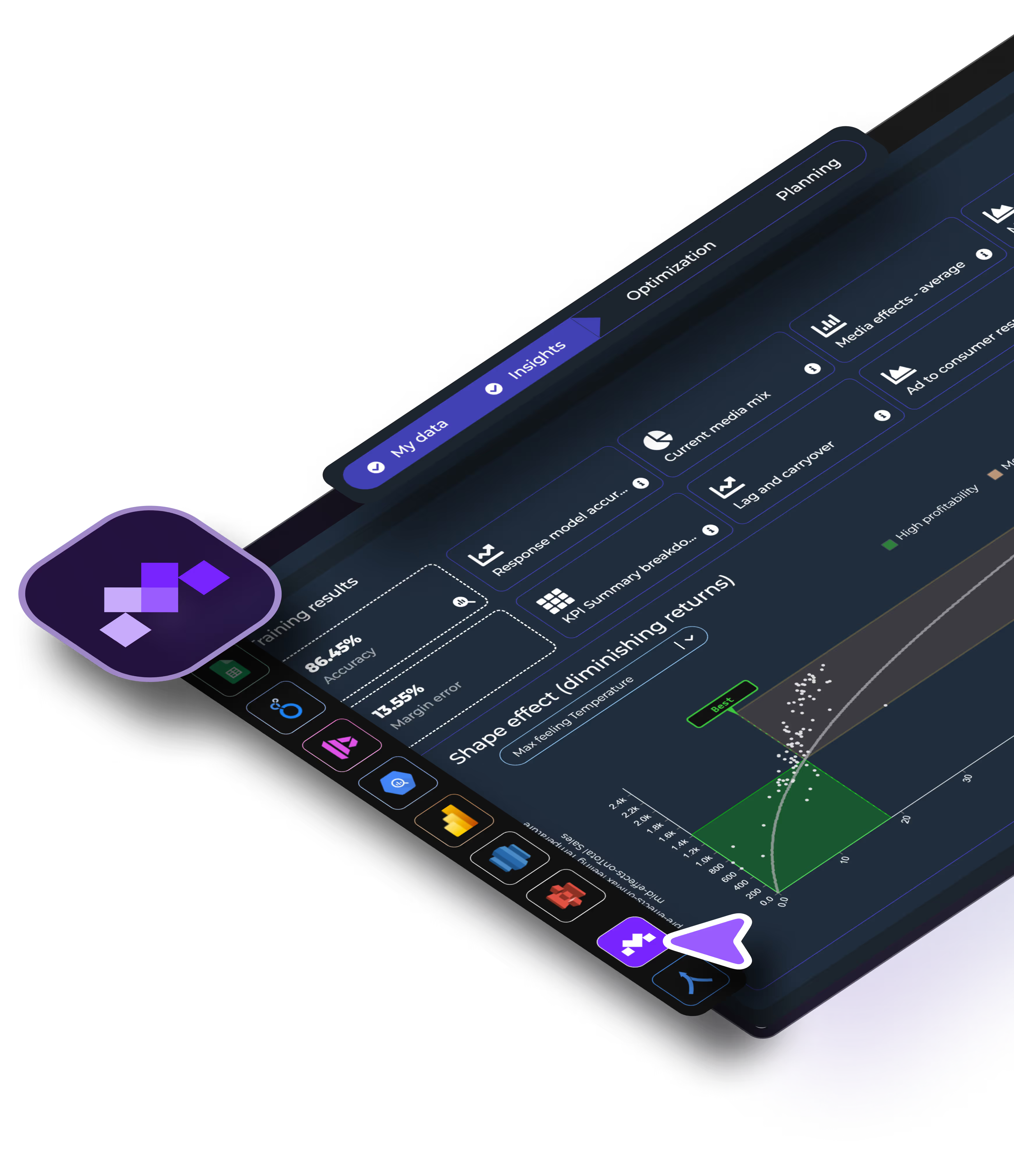Digital marketing is evolving rapidly, driven by emerging technologies and stricter privacy regulations. The elimination of third-party cookies, combined with the increased emphasis on consumer privacy, has already forced businesses to rethink how they approach data collection and measurement. To stay competitive, organizations must embrace new methodologies and technologies that provide a clearer, more reliable view of marketing performance.
This article delves into the key trends and advanced techniques currently shaping marketing measurement, with a particular emphasis on Marketing Mix Modeling (MMM), the growing importance of first-party data, and the integration of Artificial Intelligence (AI) into marketing analytics.
The Current Landscape of Marketing Measurement: Challenges and Opportunities
Digital marketing is currently undergoing significant shifts, as traditional measurement methods are being disrupted by changes in technology and privacy regulations. The elimination of third-party cookies, combined with the increased emphasis on consumer privacy, is forcing businesses to rethink how they approach data collection and measurement. These developments require brands to adopt a more consumer-centric and ethically sound approach to marketing.
The End of Third-Party Cookies and the Rise of Privacy Regulations
The phase-out of third-party cookies has already marked a pivotal shift in the digital marketing landscape. Historically, these cookies have been a cornerstone of tracking user behavior across websites and enabling highly targeted advertising. However, with growing concerns over user privacy, regulations such as the General Data Protection Regulation (GDPR) in Europe and similar laws in other regions have made these practices unsustainable. Businesses now face increasing pressure to respect consumer privacy and ensure data collection practices are transparent and compliant.
This shift is challenging, particularly for traditional attribution models like Multi-Touch Attribution (MTA), which rely heavily on granular user-level data to assign credit across various touchpoints. The inability to track individual user interactions as precisely as before complicates the measurement of marketing effectiveness. However, these challenges also present a unique opportunity. Brands that prioritize transparency and adopt privacy-first strategies can build stronger, more trusting relationships with their customers. This trust can lead to deeper engagement and loyalty, providing a competitive advantage in an increasingly privacy-conscious marketplace.
The Growing Importance of First-Party Data
As reliance on third-party data diminishes, first-party data has already become an invaluable asset for marketers. First-party data refers to the information that businesses collect directly from their own customers, such as through website interactions, customer surveys, and purchase histories. Unlike third-party data, which may be less accurate and harder to verify, first-party data is more reliable and aligned with the specific needs of the business.
Collecting and managing first-party data in an ethical and transparent manner is now crucial for businesses aiming to maintain customer trust while still delivering personalized, relevant marketing experiences. This data not only helps improve customer segmentation and targeting but also provides insights into customer preferences and behaviors that can drive more effective marketing strategies. As privacy regulations continue to evolve, companies that focus on building robust first-party data strategies will be better positioned to navigate the shifting regulatory landscape and deliver marketing that is both effective and compliant.
Key Trends in Marketing Measurement for 2025
Several key trends are emerging that will shape the future of marketing measurement. These trends are currently shaping how businesses adapt to a rapidly changing environment, providing new ways to improve campaign effectiveness and optimize marketing spend. Below are the critical developments marketers are leveraging in 2025.
1. Marketing Mix Modeling (MMM): The Strategic Pillar for 2025
Marketing Mix Modeling (MMM) has established itself as one of the most robust and reliable methodologies for measuring the impact of marketing investments. Unlike traditional attribution models, which often focus on tracking individual user behavior, MMM takes a broader approach by analyzing aggregated data over time. This allows businesses to evaluate the overall impact of various marketing activities and channels, enabling them to make data-driven decisions that can optimize ROI across the entire marketing mix.

MMM is already at the core of effective marketing measurement strategies in 2025. The need for more holistic, data-driven insights has led to the development of sophisticated platforms that streamline the process, such as Morpheus, the MMM platform by Dataslayer. Morpheus offers an advanced solution for marketers seeking a deeper, more actionable understanding of their marketing performance, combining data from multiple channels and providing strategic insights into budget allocation and campaign effectiveness.
Benefits of MMM:
- Budget Optimization: One of the primary advantages of MMM is its ability to identify the most efficient ways to allocate marketing budgets across different channels. By examining how different activities contribute to overall business outcomes, MMM helps companies maximize their ROI over the long term, ensuring that marketing investments are being used as effectively as possible.
- Multi-Channel View: In an increasingly fragmented marketing landscape, MMM provides a holistic view by analyzing the combined effect of multiple channels. This is particularly valuable as consumer behavior becomes more complex, with people interacting with brands across various platforms and touchpoints. MMM allows companies to understand how each channel contributes to the broader marketing strategy, facilitating more informed decision-making.
- Alignment with Business Goals: MMM is not just about tracking individual channel performance. It ensures that marketing efforts are aligned with a company’s broader strategic objectives. By focusing on how marketing activities contribute to business goals, MMM provides a clearer link between marketing spend and business outcomes, making it easier to assess whether the marketing strategy is driving the desired results.
With tools like Morpheus, businesses can integrate MMM more seamlessly into their workflow, allowing for faster analysis, more accurate forecasts, and better overall decision-making. As businesses face increasing pressure to demonstrate marketing effectiveness, adopting platforms that simplify and enhance MMM will be key to staying competitive in 2025.
2. Artificial Intelligence as a Driver of Innovation
Artificial Intelligence (AI) is revolutionizing marketing measurement, bringing new capabilities to personalize customer experiences and optimize campaigns in real time. By leveraging AI, businesses can automate repetitive tasks, improve decision-making processes, and deliver highly personalized marketing experiences at scale. Tools like Generative AI (GenAI) and autonomous agents are playing an increasingly central role in transforming how businesses approach marketing in 2025.
How AI Enhances Measurement:
- Personalization at Scale: AI-powered tools, such as chatbots, recommendation engines, and content generation platforms, will allow brands to create highly personalized experiences for individual users at scale. These tools can analyze vast amounts of data to deliver relevant content, products, and offers based on a customer's preferences, behavior, and previous interactions with the brand. AI not only enhances customer engagement but also enables businesses to measure the impact of these personalized experiences in real time, improving marketing outcomes.
- Real-Time Optimization: The integration of AI in marketing analytics is making real-time campaign optimization a reality. AI-powered reporting tools, like Dataslayer, allow businesses to process and analyze data on the fly, providing real-time insights that enable instant adjustments to campaigns based on consumer interactions. This ability to make immediate, data-driven decisions helps improve the efficiency of marketing campaigns, ensuring that resources are being allocated to the most effective tactics as market conditions change.
3. Data Triangulation: Validation and Accuracy
Data triangulation has become increasingly essential as businesses seek greater accuracy and reliability in their insights. This approach involves using multiple data sources and methods to cross-validate findings, ensuring that marketing decisions are based on robust and reliable data. By combining qualitative and quantitative analysis, marketers can obtain a more comprehensive and nuanced understanding of consumer behavior, which leads to better-informed strategies and outcomes.
Relevant Types of Triangulation:
- Data Triangulation: This involves combining different data sources, such as customer surveys, website analytics, social media metrics, and sales data, to gain a fuller picture of marketing performance. By cross-referencing data from various platforms, businesses can ensure the accuracy and completeness of their insights, minimizing the risk of relying on incomplete or biased data.
- Methodological Triangulation: This approach incorporates different research methods to study the same phenomenon, such as using both qualitative techniques (e.g., interviews, focus groups) and quantitative methods (e.g., surveys, analytics). By using multiple research methods, businesses can address different aspects of consumer behavior and marketing performance, leading to a more well-rounded understanding of the data.
- Temporal and Spatial Triangulation: Collecting data across different time periods and geographies allows businesses to identify trends, shifts, and fluctuations in consumer behavior. This type of triangulation is particularly valuable when businesses need to understand how external factors, such as seasonal changes or regional preferences, affect marketing performance. It helps companies tailor their strategies to specific timeframes and locations, ensuring they are responsive to dynamic market conditions.
Recommendations for Marketing Leaders in 2025
Businesses must be proactive in adopting sophisticated approaches and leveraging technological advancements. To accurately assess the impact of their investments and optimize ROI, companies need to continuously refine their measurement strategies. Below are key recommendations for marketing leaders to ensure they remain competitive and effective in this shifting landscape.
1. Prioritize First-Party Data
With privacy regulations tightening and the decline of third-party cookies, first-party data has already become an invaluable asset. Marketing leaders should invest in the collection, management, and ethical use of first-party data, information gathered directly from customers through interactions, purchases, and engagements with the brand. Ensuring transparency and obtaining explicit customer consent is critical in fostering trust. This data not only helps create more personalized experiences but also enables businesses to strengthen customer relationships, improve targeting, and enhance overall marketing effectiveness.
2. Adopt Advanced Measurement Tools with AI
The integration of Artificial Intelligence (AI) into marketing measurement is essential. Next-generation Marketing Mix Modeling (MMM) platforms, powered by AI, like Morpheus, offer the capability to deliver faster, more precise insights into the effectiveness of marketing investments. These AI-driven tools optimize budget allocation, improve forecasting accuracy, and enhance campaign performance by analyzing large data sets in real time. By adopting such tools, marketing teams can make informed decisions quickly and adjust strategies on the fly, ensuring that resources are being used most effectively.
3. Foster a Culture of Continuous Experimentation
To stay ahead in a competitive market, businesses must integrate experimentation into their daily operations. Incrementality tests, such as A/B testing, geo-lift studies, and other controlled experiments, should be standard practice in evaluating marketing strategies. Continuous experimentation helps validate assumptions, refine hypotheses, and assess the actual impact of marketing initiatives. By making data-driven decisions based on experimental evidence, businesses can continually improve their campaigns and adapt to changing market dynamics, driving better outcomes over time.
4. Measure Beyond Direct Attribution
Traditional measurement approaches often focus heavily on immediate, short-term results, such as conversions or sales. However now it requires a broader perspective. Companies should look beyond direct attribution metrics and consider long-term effects such as brand affinity, customer loyalty, and customer lifetime value (LTV). Tracking these factors helps businesses understand how marketing efforts contribute to lasting relationships with customers, rather than just quick wins. By measuring these longer-term metrics, marketing leaders can align their strategies with overall business growth and sustainability.

5. Integrate Measurement Tools and Methodologies
Today's increasingly complex marketing environment, it’s essential to use an integrated approach to measurement. Combining Marketing Mix Modeling (MMM) with Multi-Touch Attribution (MTA) and incrementality tests allows for a comprehensive view of marketing performance. This multi-method approach provides both a macro-level and micro-level perspective, helping businesses understand how different touchpoints and channels contribute to overall success. Additionally, data triangulation, integrating multiple data sources to cross-verify findings, ensures the accuracy and reliability of the insights, ultimately leading to more informed decision-making and better strategy optimization.
Conclusion
The future of marketing measurement is already being shaped by the widespread adoption of advanced technologies, more sophisticated methodologies like Marketing Mix Modeling (MMM), and a heightened focus on privacy and first-party data. These trends are transforming how brands evaluate the effectiveness of their marketing efforts and optimize their return on investment (ROI).
For companies that successfully integrate these tools, the benefits extend far beyond just improving campaign performance. By adopting a data-driven approach to decision-making, businesses will not only improve their ability to measure and optimize their marketing strategies, but they will also build a sustainable competitive advantage in an increasingly complex and competitive market. The key to staying ahead will be flexibility, organizations must be able to adapt their measurement strategies to keep pace with evolving market dynamics, while maintaining a continuous commitment to data analysis, experimentation, and innovation.
Brands that prioritize these approaches will find themselves in a stronger position to navigate the digital marketing landscape in 2025 and beyond. By focusing on privacy, leveraging first-party data, and embracing advanced analytics platforms, companies will be able to make smarter, more informed decisions that lead to greater long-term success. As the digital marketing world continues to evolve, businesses that are proactive in implementing these strategies will be well-equipped to thrive in a more regulated and data-driven environment.







